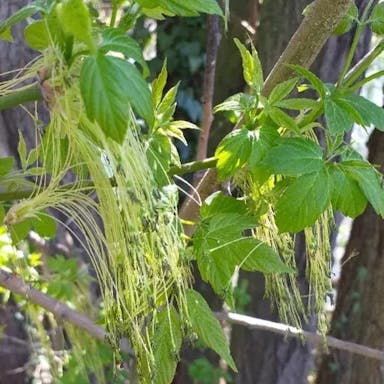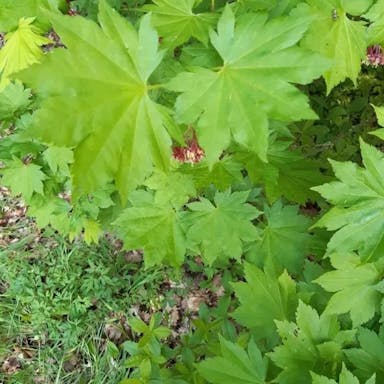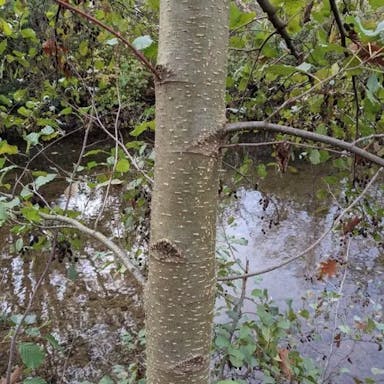Bitternut, scientifically known as Carya cordiformis, is a deciduous tree native to North America, particularly in the eastern United States and southeastern Canada. The tree produces small, greenish-yellow flowers in spring before the leaves emerge, adding ornamental value to landscapes. The tree thrives in moist, well-drained soils and full sun, making it relatively straightforward to cultivate in appropriate conditions. The leaves are pinnately compound, turning yellow in the fall. The name refers to the unpalatable flavor of its nuts, which are small, round, and enclosed in a thick, green husk. They are not typically consumed by humans due to their bitter taste.
Bitternut
- Scientific name
- Carya cordiformis
Basic Information
- Juglandaceae Family Carya Genus Bitternut Species
- Juglandaceae > Carya > Carya cordiformis
- 83%
- The Completeness of This Encyclopedia
Please help us complete the encyclopedia, Terrarium is a encyclopedia service to be completed with everyone in the world. Currently, this page is 83% complete. For more information on how to contribute, please click here.
- Broad-leaved tree
- Tree
- Height
- 10cm ~ 30cm
- Flower Color
- Leaf Color
- Anthesis
- spring
- Sunlight Exposure
Full Sun Long hours of sunlight from morning to afternoon Partial Shade A location in the shade of a tree or where either the morning or afternoon is shaded Full Shade A place where there is no direct sunlight
- Hardiness Zones
This is an indicator to know to which zone each plant can winter. Knowing the zone of each plant gives you an idea of the cold temperature resistance when grown in the ground without a roof. 2: -42.7 to -40.0 3: -39.9 to -34.4 4: -34.3 to -28.9 5: -28.8 to -23.3 6: -23.2 to -17.8 7: -17.7 to -12.2 8: -12.1 to -6.7 9: -6.6 to -1.1 10: -1.0 to 4.4 11: 4.5 to 10.0
- 4
- Cold resistance
- Excellent
- Heat resistance
- Good
- Habitat of origin
- United States, Canada
- Growth Rate
- Normal
What is Bitternut (Carya cordiformis)?
What is Bitternut (Carya cordiformis)
Flower meaning
The carnation vegetable typically symbolizes rugginess also stayer in The U.S.. Represents of language of posies: - Rugginess: typifies the flexibleness to rise back from confrontings. - Stayer: signifies the strength to endure done hard times. Clarified example: - Rugginess: The carnation vegetable typifies rugginess, reflecting the organism's might to boom in miscellaneous stipulations, symbolyzing rugginess at the front of rivalry.
Calendar of Bitternut (Carya cordiformis)
Calendar
Bitternut flowers typically bloom in late spring to early summer in the United States. The blooming period for Bitternut can last for about 2 to 3 weeks. It is essential to plant Bitternut in well-drained soil and provide regular watering during dry spells. Additionally, applying a balanced fertilizer in early spring can help support healthy flower production.
How to grow Bitternut (Carya cordiformis)
Watering
Bitternut is a plant. Monitor the soil moisture. Water when the soil is dry. Water less in winter. Overwatering causes disease. Check the soil before watering.
Soil and Fertilizer
Bitternut thrives in well-drained, acidic soils with a pH between 5.0 and 6.5. It profits from a balanced fertilizer ratio, applied in early spring before new growth commences. It's important to monitor soil quality and adjust applications to prevent deficiencies or excesses. Regular testing can determine specific needs for optimal growth and health. Fertilizer should be spread evenly, avoiding direct trunk contact. During growth, light application can be beneficial periodically.
Sunlight and Place
Bitternut thrives in sunlight or shaded areas, needing at least 6 daylight hours every day. They can withstand low temperatures to -20°F (-29°C). However, extreme heat is less tolerated, with preferred temperatures of 60-80°F (15-27°C). In summer, providing adequate water and drainage to prevent waterlogging is vital. Protecting from frost is crucial in winter. Well-draining soil and shelter from strong winds benefits them. They can tolerate some shade but do best with 6-8 sunlight hours daily.
Advanced Information of Bitternut (Carya cordiformis)
Pruning
Bitternut should be pruned to remove dead or damaged branches, improve air circulation, and promote new growth. Regular pruning works maintain the wellbeing and form of Bitternut plants, making sure they prosper and stay looking eye-catching in the greenery. Make blank cuts at a 45-degree point just preceding a bud or horizontal branch to encourage appropriate mending. Water the plant completely after pruning, and utilize a balanced fertilizer to help recovery and development. Pruning is ideally done in later winter or early spring prior to new development starting. Eliminate any crossing or scouring branches to evade harm.
Planting and Harvest
Bitternut is best potted in well-draining soil to prevent waterlogging, promoting healthy root growth. When planting, gently loosen the roots and place the plant at the same depth as it was in the nursery container. Water thoroughly after planting and place in a location with indirect sunlight. Ensure the pot has drainage holes to prevent root rot and use a potting mix rich in organic matter. Repot Bitternut every 2-3 years in a slightly larger pot to accommodate root growth. If the plant becomes root-bound, gently tease out the roots before repotting.
Propagation
Bitternut can be propagated through seeds, division, and cuttings. The seeds need well-draining soil in spring. Keep the seeds moist and warm in the sun for germination. Separate the roots into smaller sections. Do this in early spring or fall. Healthy stems can be cut and placed in water or soil. Keep them warm and humid so they will grow. A healthy leaf in soil can also work. Keep the soil moist until roots form. Using different methods together will raise your chances of success. It will give you more new plants.
Pests and Diseases
Bitternut is susceptible to various pests and diseases, including aphids, caterpillars, and fungal infections. These pests can cause damage to the leaf, fruit, branch, stem, seed, root of the botanical specimens, leading to stunted growth and reduced fruit production. To prevent these issues, regular inspection of the bush for signs of pests and diseases is essential. The small insects that feed on the sap, causing wilting and yellowing of the leaf. The caterpillars can chew through the leaf and stem, causing defoliation and weakening the bush. Fungal infections, such as white spots on the foliages and affect the overall health of the bush. Additionally, maintaining proper bush hygiene, such as removing dead or diseased botanical material, can help reduce the risk of infestations. Proper watering and fertilization can also help improve the bush's resistance to pests and diseases.
Habitat of Bitternut (Carya cordiformis)
Habitat
Toxicity of Bitternut (Carya cordiformis)
Health Benefits
- edible
- edible
- Toxic
- No toxicity
NO DATA
Toxic for dogs and cats
NO DATA
Q&A of Bitternut (Carya cordiformis)
- choice
Bitternut seedlings should be selected based on their overall health, with sturdy stems and vibrant green leaves being indicators of quality. Varieties of Bitternut may have specific characteristics including size, flavor, or resistance to certain diseases. Consider preferences and gardening goals when selecting between varieties. Observe a well-established root system lacking any indications of rot or damage. The seedlings require freedom from pests or diseases, which may impair growth and development. For enhanced garden establishment, the recommended height stands between 6-12 inches. When opting for Bitternut seeds, choose plump, firm seeds lacking any indications of mold or discoloration. Avoid shriveled or damaged seeds, as they may possess lower viability rates.











